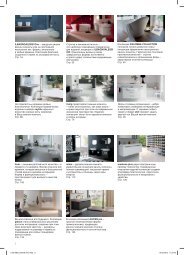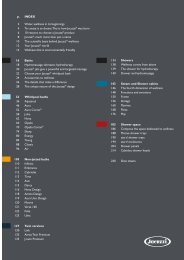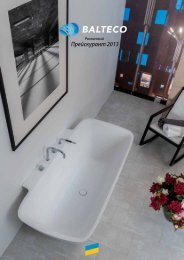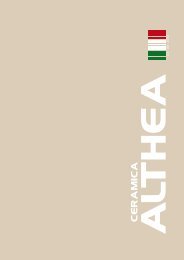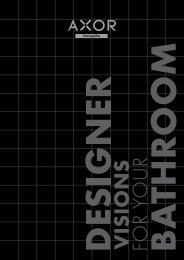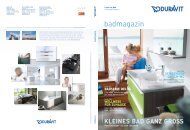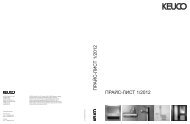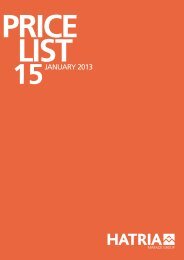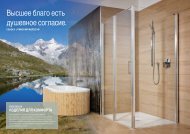You also want an ePaper? Increase the reach of your titles
YUMPU automatically turns print PDFs into web optimized ePapers that Google loves.
RECOMMENDATIONS FOR INSTALLATION<br />
When choosing ceramic tiles and the types of materials to be used in<br />
their installation, the following factors must be taken into consideration:<br />
- Wall and floor tile characteristics.<br />
- Characteristics of the installation substrate.<br />
- Characteristics of bonding materials.<br />
- The expected structural perfomance of the surface on which installation<br />
will be performed.<br />
- Ambient conditions to which tiles will be exposed to.<br />
- The use to which tiles are to be put.<br />
In drawing up these recommendations, we have based ourselves on THE<br />
CERAMIC TILE GUIDE.<br />
The purpose of this guide is to promote quality in building practices, and<br />
it provides information about the proper specification in each phase of<br />
the process, as well as about ceramic tile installation and use.<br />
GDV recommends that you request information about adhesives and<br />
grouting materials from your regular supplier, who will best be able to<br />
help you.<br />
INSTALLATION SYSTEM AND BONDING MATERIAL:<br />
In order to determine what installation system is used, it will be necessary<br />
to take into account the data previously defined in the selection process<br />
such as tile type and format, whether tiles are installed in interiors or<br />
exteriors, and the prior considerations pertaining to the substrate.<br />
There are two installation systems to be considered: the thick-bed system<br />
and the thin-bed system.<br />
Thick-bed installation:<br />
This is the tradiotional system, whereby tiles are placed directly on the<br />
substrate, although type-1 sand bedding needs to be laid for floors. For<br />
thick-bed installations, traditional mortar, pre-mixed mortar or additiveenhanced<br />
cement is used for the preparation of the mortar (CM).<br />
This is the most affordable system. It allows for the compesation of<br />
greater defects in planarity. It does not require preliminary substrate<br />
preparation.<br />
Thin-bed installation:<br />
Installation is performed on top of a regulating layer previously applied<br />
to the substrate, whether on parge coats (walls) or mortar screeds<br />
(floors).<br />
This system is suitable for use with all types of tiles and is compatible<br />
with all types of substrates. There are adhesives designed for each type<br />
of installation and they are easy to use. Their use prevents the need for<br />
on-site mixing and they have a high degree of adjustability. They allow<br />
for greater deformability in the substrate and have a higher degree of<br />
bonding strength.<br />
With the thin-bed method, cement-based adhesives, or glue-mortars,<br />
paste adhesives and reactive resin adhesives are used.<br />
> 140<br />
· Cement-based adhesives (glue-mortars):<br />
These are composed of a hydraulic binder (Portland cement), sand and<br />
polymeric and organic additives.<br />
Several types are available:<br />
1) Conventional glue-mortar (A1)<br />
2) Glue-mortar especially for plaster (A2)<br />
3) High-performance glue-mortar (C1). It has greater bonding strength<br />
than conventional mortar.<br />
4) Glue-mortar with mixed binders (C2). Belonging to this group are<br />
those glue-mortars containing a high ratio of polymeric resins (latex),<br />
and which have a high degree of adherence and elasticity.<br />
· Dispersion adhesives (Adhesive pastes) (D):<br />
These are made up of a binder in aqueous polymeric dispersion, sand<br />
and organic additives.<br />
They have a paste-like consistency and ready to use.<br />
· reactive resin adhesives (R):<br />
They are made up of a reactive resin (epoxy or polyurethane), a hardener<br />
(polyamines or polysocianate) and a mineral load (silica sand).<br />
Hardening is produced via a chemical reaction; these are generally twocomponent<br />
products.<br />
CHARACTERISTICS OF BONDING MATERIALS:<br />
- An essentials characteristic:<br />
In choosing a bonding material, a very important factor is the adherence<br />
or bonding strength established between ceramic tiles and the substrate.<br />
This may be of two types:<br />
· Mechanical adhesion: this is based on the penetration of the gluemortar<br />
or adhesive into the pores of the materials to be bonded together.<br />
Mechanical adhesion predominates among cement-based adhesives.<br />
· Chemical adhesion: covers the formation of chemical bonds between<br />
the adhesive and the piece. Chemical adhesion predominates among<br />
polymeric resin-based adhesives.<br />
- Other characteristics:<br />
· <strong>De</strong>formability: in installations on substrates where an average to high<br />
degree of movements is expected, or which are exposed to strong<br />
vibrations or thermal changes, the following measures should be taken;<br />
the use of a deformable adhesive, the selection of a tile format smaller<br />
than 30 x 30 cm, increased installation joint width, and an increased<br />
number of expansion joints.<br />
· Resistance to permanent contact with water.<br />
· Open time: the maximun time interval after the application of the<br />
adhesive, during which tiles may be installed without the adhesive losing<br />
its proper degree of bonding strength. Exceeding an adhesive´s open<br />
time is a frequent cause of tiles becoming detached. It is recommended<br />
not to spread the adhesive in sections greater than 2 m 2 and to regularly<br />
check the stickiness of the adhesive by prising up an already installed<br />
tile.<br />
INSTALLATION SYSTEM BONDING MATERIAL ADHERENCE DEFORMABILITY RESISTANCE TO CONTACT WITH<br />
WATER<br />
Thick bed CM - Cement mortar Low Slight Average<br />
Thin bed<br />
A1 - Glue-mortar Average Slight Good<br />
A2 - Glue-mortar special for plaster Average Slight Average<br />
C1 - High-performance Glue-mortar Average-High Slight Very Good<br />
C2 - Glue-mortar w/mixed binders High High Good<br />
D - Paste Adhesives High High Slight<br />
R - Reaction resins Very High Average Very Good



